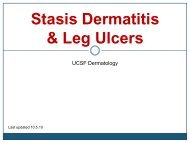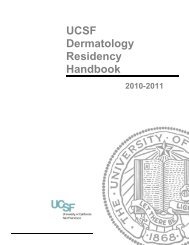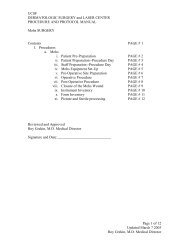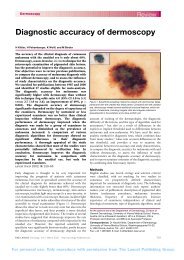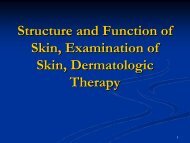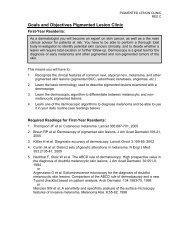An overview of sexually transmitted diseases. Part III ... - Dermatology
An overview of sexually transmitted diseases. Part III ... - Dermatology
An overview of sexually transmitted diseases. Part III ... - Dermatology
Create successful ePaper yourself
Turn your PDF publications into a flip-book with our unique Google optimized e-Paper software.
Directions for questions 1-16: Give single best response.<br />
1. A patient with AIDS comes to your clinic with her first<br />
case <strong>of</strong> genital herpes. A good estimate <strong>of</strong> the likelihood<br />
that her infection will be resistant to acyclovir is<br />
a. less than 1%<br />
b. 3%<br />
c. 6%<br />
d. 12%<br />
e. 24%<br />
2. A patient comes to your clinic with AIDS and a history<br />
<strong>of</strong> anal warts. Each <strong>of</strong> the following is true except<br />
a. patients with AIDS generally have more human<br />
papillomavirus (HPV) subtypes present in their<br />
infections.<br />
b. as his CD4 cell counts drop, this patient will shed<br />
more HPV virions.<br />
c. concurrent HIV and anal HPV infections increase<br />
this patient’s risk for anorectal carcinoma.<br />
d. optimizing his antiretroviral medications may<br />
make management <strong>of</strong> any anal wart recurrences<br />
more feasible.<br />
d. acetic acid is not a useful diagnostic tool for recognizing<br />
anal squamous intraepithelial lesions in this<br />
patient.<br />
3. Kaposi’s sarcoma (KS)<br />
a. is not associated with human herpesvirus type 8 in<br />
HIV-infected patients<br />
b. is associated with an increased risk for non-<br />
Hodgkin’s lymphoma in HIV-infected patients<br />
c. occurs most commonly among people who<br />
acquired HIV through intravenous drug abuse<br />
d. occurs at similar rates for HIV-infected patients in<br />
all US cities<br />
e. does not follow the epidemiologic patterns <strong>of</strong> an<br />
infectious disease<br />
4. The best approximation for the number <strong>of</strong> scabies<br />
mites on an HIV-infected patient with crusted scabies<br />
is<br />
a. fewer than 5<br />
b. 5-10<br />
c. 10-20<br />
d. 20-50<br />
e. more than 50<br />
5. In the treatment <strong>of</strong> AIDS patients with crusted scabies,<br />
which <strong>of</strong> the following medications has been<br />
CME examination<br />
Identification No. 800-109<br />
Instructions for Category I CME credit appear in the front advertising section. See last page <strong>of</strong> Contents for page number.<br />
Questions 1-31, Czelusta A, Yen-Moore A, Tyring SK. J Am Acad Dermatol 2000;43:409-32.<br />
documented as a potential cause <strong>of</strong> severe neurologic<br />
side effects in case reports?<br />
a. Lindane<br />
b. Permethrin<br />
c. Mebendazole<br />
d. Metronidazole<br />
e. Ivermectin<br />
6. The most likely mechanisms by which herpes simplex<br />
virus (HSV) mediates resistance to thymidine kinase<br />
inhibitors includes each <strong>of</strong> the following except<br />
a. production <strong>of</strong> viral thymidine kinase with decreased<br />
substrate affinity<br />
b. production <strong>of</strong> viral DNA polymerase with decreased<br />
substrate affinity<br />
c. decreased production <strong>of</strong> viral thymidine kinase<br />
d. absence <strong>of</strong> viral thymidine kinase production<br />
e. altered transport <strong>of</strong> thymidine kinase inhibitors<br />
into infected cells<br />
7. <strong>An</strong> HIV-infected patient who is allergic to penicillin<br />
comes to your clinic with early latent syphilis. Which<br />
<strong>of</strong> the following antibiotics is the most appropriate<br />
therapy?<br />
a. Intramuscular benzathine penicillin G<br />
b. Oral cipr<strong>of</strong>loxacin<br />
c. Oral erythromycin<br />
d. Intravenous vancomycin<br />
e. Intramuscular ceftriaxone<br />
8. Chancroid in HIV-positive patients<br />
a. is commonly atypical in its clinical presentation<br />
b. presents with larger ulcers than those seen in HIVnegative<br />
patients<br />
c. has distinct histologic differences from HIV-negative<br />
patients on microscopic examination<br />
d. increases the risk <strong>of</strong> HIV transmission to sexual<br />
partners<br />
e. cannot be cured by the same antibiotic regimens<br />
that are recommended for immunocompetent<br />
patients<br />
9. A patient with advanced AIDS presents with a facial<br />
molluscum contagiosum. Which <strong>of</strong> the following<br />
should he be told about the lesion?<br />
a. Shaving his face will help improve skin cleanliness<br />
and decrease the likelihood <strong>of</strong> new lesions developing.<br />
b. Optimization <strong>of</strong> his antiretroviral medications will<br />
not help in the care <strong>of</strong> this lesion.<br />
433




